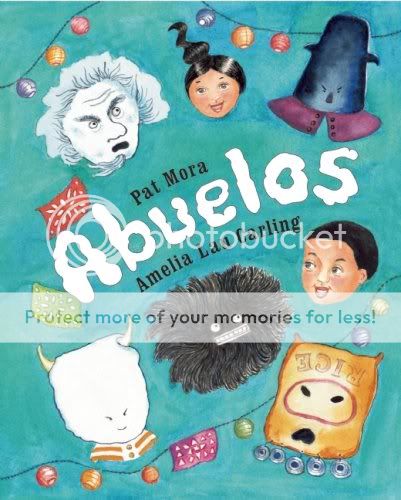This giveaway is now closed. Congratulations to our winner: Melissa Davis!
One of the parts I love the most about SpanglishBaby is all the discoveries I’ve made of things I would’ve never known existed otherwise–this has been particularly true in the area of books.
As you probably know by now, back in July we launched our newest monthly series, which we call: ReadMe. We have teamed up with several Bilingual/Spanish children’s book publishers to bring you a review of a new book every month. The post includes an interview with the author in which we specifically touch upon the subject of raising bilingual and bicultural children.
 Ana Lilian and I decided to create ReadMe because we wanted to have a series dedicated exclusively to literacy and bilingualism. We have all heard about the importance of reading when raising bilingual kids. We want to reinforce how fundamental this activity is by highlighting the options we all have available when it comes to bilingual children’s literature.
Ana Lilian and I decided to create ReadMe because we wanted to have a series dedicated exclusively to literacy and bilingualism. We have all heard about the importance of reading when raising bilingual kids. We want to reinforce how fundamental this activity is by highlighting the options we all have available when it comes to bilingual children’s literature.
We also want to encourage you to read to your children or – if they’re old enough to do it themselves – to help you inspire them to do so. That’s why each monthly ReadMe will also include a giveaway of the book we’ll be reviewing ![]()
Abuelos by Pat Mora
Although Pat Mora, the author of this month’s ReadMe book, is no stranger to SpanglishBaby, the subject matter she writes about was a mystery to me prior to reading the wonderful story she came up with for her book titled, Abuelos. And, since we’re celebrating Hispanic History Month until Oct. 15, I thought this would be the perfect book to do so. Let me tell you why…
When Groundwood Books, the publisher of Mora’s Abuelos, suggested this book, I erroneously assumed from the title that it was a book about just that: abuelos or grandparents. Oh, was I in for a big and pleasant surprise.
I have always been incredibly interested in the study of cultural traditions and customs. In fact, if I hadn’t become a journalist, I always dreamed of being an anthropologist or a sociologist. I’m pretty intrigued by people and their ways. Therefore, I was thrilled after I read Mora’s book and found out that Abuelos is actually the name of a New Mexican tradition that goes back hundreds of years and it’s a bit like Halloween (because of the costumes) and Christmas (because of the ‘you better be good’ concept) mixed together, but not really…

Pat Mora
You see, legend has it that in the middle of the winter in northern New Mexico, the men from the village would go up the mountains, dress up like sooty, old men with scary masks (abuelos) and then they would go back down to check if the village’s children were behaving. The day this tradition takes place, the villagers build big bonfires and everyone gathers around them. The abuelos try to catch the children and then they have them dance and sing around the fire. The whole spectacle ends with a fiesta at one of the villager’s home where traditional treats are served and everyone has a great time! Doesn’t that sound awesome?
Mora tells the story of this tradition as seen through the eyes of two niños who experience it for the first time. The hermanos, who’ve recently moved to a small New Mexican community with their family, have been told about the tradition, but are not really sure whether it’s true or not nor when and how it’ll actually take place. More than anything, it seems as if they’re not sure whether to be scared or just simply amused by the long-standing tradition. The illustrations, by artist Amelia Lau Carling, are perfectos for this kinda-scary story with a happy ending?
The book was originally written in English with a few Spanish words sprinkled all about, but there’s also a Spanish version. In this case, however, I think the main thing about this book is that it’s a great tool to teach our niños about cultural traditions. And, even though, they might not be our own traditions, customs like this one are a good way to reinforce the importance of heritage and language–as we’ve said many times in the past.
The Giveaway:
Part of ReadMe includes the opportunity to win a copy of the book being reviewed. If you’ve read any of Pat Mora’s children’s books, then you know this is one you need to add to your collection. And, if you haven’t, this is your chance to discover a great Latina author. I promise you won’t be disappointed. To win, all you have to do is share with us a cultural tradition you like your children to know about. It’s that easy!
This giveaway ends at midnight EST on Sunday, Sept. 27, 2009. Only valid U.S. shipping addresses.
Entries/Comments that do not follow the submission guidelines will be invalid and automatically deleted. Sorry, just need to keep it fair. Good luck to all!





Love the website.
I would like my children to know about Jewish cultural traditions, specifically the Passover seder, which is meaningful for me culturally and personally.
This is something we will have to make a deliberate effort to share with them, since we don’t know any other Jewish families here in Brazil!
(Yes, I do have a U.S. address, though, just in case I win the drawing!)
I like my children to know that we eat a big meal and open presents on Christmas Eve because of the Swedish part of their heritage.
Unfortunately our family has not held on to many cultural traditions. The only one I can think of comes from our German side of the family, where we make our secret family recipe of sausage at Christmas time. The recipe has been handed down from generation to generation and I’m not sure if anyone knows where it originated. We all get together, grind the meat, season it, and form it into links. It’s lovely and everyone gets some to take home.
Now that my kids and I involved in our dual language program at school, we have learned to appreciate many of the Latino traditions, specifically Dia de los Muertos. We make the sugar skulls and decorate an ofrenda, with pictures of deceased relatives. We like remembering our past loved ones and honoring them. Though it is not our culture, we value it and have made it our own.
.-= melissa davis´s last blog ..building community, one tree at a time =-.
Not really many cultural traditions here either, sadly. We should create one. We do hide the pickle ornament on the tree and have an annual fishing derby each year. I guess that will have to do for now. Thanks! thebubbledies(at)gmail(dot)com
.-= simone´s last blog ..Family vacation in style =-.
When I was growing up my grandmother would make “homemade” gnocchi on the 29th of each month and she would put money under our plates. It’s a tradition that came to Argentina with the Italian immigrants. It’s called “ñoquis del 29″. I didn’t have to guess what we would eat that day. As soon as I found out it was the 29th I knew I would be having gnocchi for lunch! I would love to go back to that tradition with my own kids. It’s just fun!
Here is how wikipedia explains this tradition in Latin America:
There are two popular explanations for these customs. One is that this is the day before payday, when money was tight and gnocchi were cheap and hearty fare. The other is that the 29th is the feast day of Saint Pantaleon, one of the patron saints of Venice, who was canonized on this date. Pantaleon was a doctor in the 8th century who, upon converting to Christianity, made a pilgrimage across Northern Italy. Along the way, he practiced miraculous healings that to his sainthood. On one occasion, he asked some poor farmers for a little bread, and they invited him to share their meagre meal. He blessed the farmers, who reported abundant crops the next year. Eating simple food (represented by the ñoquis) on his feast day is the customary way to honor that miracle and ask for prosperity and blessings.
When I was growing up in Peru, we stayed up late on Dec 24th. As soon as midnight rolled around we all hugged and wished each other Merry Christmas. Then we sat down and had Christmas dinner, and for dessert hot chocolate and pannetone (a sweet bread, originated in Italy I believe). Only after that were we allowed to open presents!
My husband (who is american) and I, have adapted this tradition… we just skip the food after midnight
I love the Bolivian custom where each child at the birthday party says a special blessing or wish about the birthday boy or girl. Our family is not very good at traditions, but we’re working on it…and also working on the bilingual part. It is definitely harder here in the States for us and them to remember to speak in spanish, but your website has encouraged us to keep trying. Thank you!
.-= Susan´s last blog ..science museum =-.
I love celebrating the Rosca with my family. It is not a tradition I grew up w/, but my husband’s family does it. One night (Dia de los Reyes Magos, January 6) his family eats dinner and after dinner, they cut the rosca and everyone has a piece. Whoever’s piece has a baby Jesus doll inside is responsible for cooking at the next celebration on
Feb 2. We don’t live near my in-laws, so this year we just ate tamales and rosca at home.
I want my children to learn all about the traditions of Christmas time in my family. For me it means posole, tamales, beans and bizcochitos and I want the smells and tastes to be things they remember during this time too…
We love making tamales and giving them out at Christmas and of course, there is the huge Mexican feast on Christmas eve
.-= Tati´s last blog ..Immersion Class: Los Animales de la Granja =-.
We do Dia de los Muertos here! I have *loved* making an ofrenda every year, even before my son came along! Escited that he’ll be able to help with it a little more this year. We also do Dia de los Reyes. My husband, who is Mexican, picks out two presents to give him on the 6th.
Sadly, not much for cultural traditions here either. It’s embarrassing, really.
We have been (and are planning to do more) traveling. Much of our plans include South American countries. We have young children to whom I trying to teach Spanish, without knowing much myself. I’m on the lookout for resources – especially bilingual audio. That’s what has brought me to this blog.
Thanks for letting me take a peek around.
I would love to share with my children the “posadas” I would like to explain their meaning, and the original meaning of the pinatas (which were born in this fun celebration). Love Christmas time in Mexico!
.-= Silvia´s last blog .."Con Kleenex Celebra tu Hispanidad" / "Express your Hispanic Pride with Kleenex" =-.
My kids love hearing stories of when I was a little girl and one of my favorites is also Las Posadas. I enjoy telling them how my family and friends would gather at someone’s house and divide into groups singing back and forth, half of us outside, the other half in. And how special I felt to be able to carry los peregrinos. One of the traditions I keep closest to my heart…
.-= Monica´s last blog ..My First Book of Spanish Words =-.
I would love to teach my grandchildren the tradition of serenading people, on their birthdays and at other times. That is one of my favorite memories from living in Latin America.